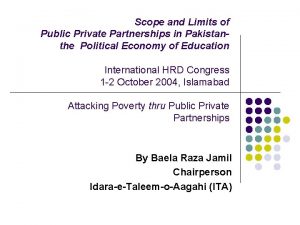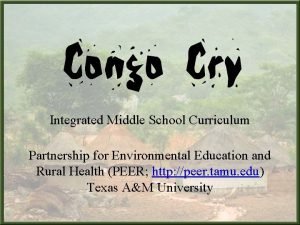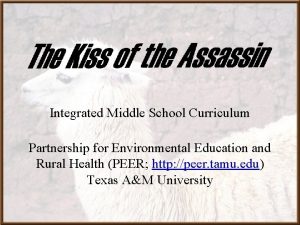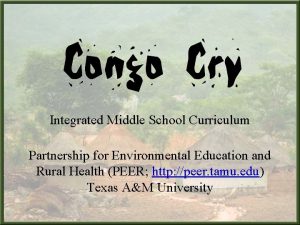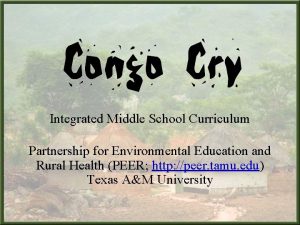Integrated Middle School Curriculum Partnership for Environmental Education







































































- Slides: 71

Integrated Middle School Curriculum Partnership for Environmental Education and Rural Health, Texas A&M University http: //peer. tamu. edu

Primary Authors: Jon Hunter Bill Klemm Deborah Kochevar Jim Kracht Based on a story by Marguerite Swilling Design: Jeremiah Mc. Nichols A Production of the Partnership for Environmental Education and Rural Health funded by NIEHS, Larry Johnson, PI

Mr. or Ms. Smith’s class Your Middle School

Investigator’s Challenge Quiz • Review the story Dark Poison. • Test your knowledge of the story by taking the Investigator’s Challenge Quiz. • After you complete the quiz, return to the story and identify where to find each correct answer. DP-0. 5

The U. S. had few large cities in 1830. BOSTON NEW YORK CINCINNATI PHILADELPHIA BALTIMORE ST LOUIS CHARLESTON NEW ORLEANS Throughout the 19 th century, the United States became more urbanized as people moved to the cities. DP-1. 0

More people lived in rural areas than in cities in 1830. • In 1830, cities were growing rapidly, but most Americans still lived in rural areas. • The largest cities in the U. S. included New York, Philadelphia, Boston, Baltimore, Charleston, and New Orleans. • Why were cities growing? DP-2. 0

Where were major U. S. cities in 1830? Some of the largest cities in the U. S. were: BOSTON NEW YORK PHILADELPHIA BALTIMORE CHARLESTON NEW ORLEANS New York City Charleston Baltimore Boston New Orleans Philadelphia Point out where each city is located. DP-3. 0

The first major U. S. cities BOSTON NEW YORK PHILADELPHIA BALTIMORE CHARLESTON NEW ORLEANS DP-4. 0 What do all of these cities have in common?

New York City Grows • In 1800, New York City had a population of 61, 000. • By 1850, New York’s population had grown to 516, 000. • What caused New York’s rapid growth? DP-5. 0

Life in the Cities • Life in a city in the 1830 s could be good if you were wealthy. • The majority of city residents were poor and lived in very bad conditions. • Which type of life did most immigrants have? DP-6. 0 This illustration highlighted the differences in living conditions between rich and poor in New York City. • To learn more about where immigrants to America came from during this period, see the Immigration supplement.

Garbage in the Cities • In the 1830 s, city streets were often covered with garbage. • Pigs roamed the streets eating the garbage. They often were the city’s main way of keeping the streets clean. • In New York City, pigs were not outlawed from the streets until 1867. • Why aren’t pigs used to keep streets clean today? DP-7. 0

Food in the Cities • City dwellers could not grow their own food, so they spent much of their money on food. • Bread was a major part of the diet of most city laborers. • Meat was an expensive luxury. • How might diet have affected the health of adults and children in the city? DP-8. 0

Water Supply in Cities • Urban water wells were often contaminated by garbage, human waste, and even dead animals. • The contaminated water spread diseases. • How are urban water supplies protected today? DP-9. 0

Health Care in the Cities • In the 1830 s, health care and medicine were luxuries for the poor. Most had to depend on charity doctors. • There was little health care for the poor in the 1830 s. • By 1890, New York City employed 50 doctors to give free care to the poor. • What similarities and differences are there between health care today and in the past? DP-10. 0

The Effects of Crowded Conditions • Crowded housing contributed to the rapid spread of disease among workers and their families. • What diseases can be spread through close contact with others? DP-11. 0

People Lived Near Their Work • Most people who lived in cities walked to work. • Poor neighborhoods were very crowded and were often located near factories and other dirty and unhealthy places of work. • How could such living conditions affect the health of the people? DP-12. 0

Living in a Tenement • A tenement was a large building divided into many small apartments. • Many rooms had no windows and no way to let in fresh air. • Many immigrant families lived in a single room of no more than 200 square feet. • How does that compare to space in U. S. homes today? DP-13. 0

Housing in the Cities • Tenements stood between four and six stories tall, and generally had four apartments per floor. • The back of the same lot often held another, smaller tenement building, and buildings were crowded closely together. DP-14. 0 • Why did immigrants tolerate such crowded conditions?

Irish Immigrants • Many immigrants to the United States in the 19 th century came from Ireland. • What conditions in a country might cause people living there to want to leave the country? • To learn why so many Irish citizens left their country in the 19 th century, see The Irish Diaspora. DP-14. 5

Even Sleeping was Dangerous • The dark, unventilated rooms made tenements very unhealthy places. • In summer, people tried to escape the stuffy apartments by sleeping on roofs, fire escapes, and even windowsills. • These were dangerous places to sleep. Some people died from rolling off their perches in their sleep. DP-15. 0

Housing in the Cities • Tenements were not great places to live. There were frequent outbreaks of disease, little privacy, and the buildings were very dirty. • One tenement in New York City known as the “Dirty Spoon” was said to have caught fire six times in one winter. The residents were supposedly saved by the years of dirt covering the walls, which smothered the flames. DP-16. 0

Reform of the Tenements • Life in the tenements began to improve with reform movements starting in the 1890 s. • New tenements were built with windows or airshafts for every room and old tenements were renovated to include the same improvements. • What forces brought about change in the crowded tenements? DP-17. 0

Sugar Cane • The story talks about slaves being used to grow sugar cane in the South. • What is sugar? Click here for information on the biology of sugar cane. • What does sugar do in the body? Click here for more information. DP-18. 0

Why sugar and not starch? • Plants trap and convert carbon dioxide into sugar-like compounds. • Most plants combine many glucose molecules as a long string of molecules, “starch. ” • About 20% of all the chemicals in sugar cane is sucrose. Can you guess what sugar cane must do to make so much sugar instead of starch? Hint: It takes a series of chemical reactions to make sugar or starch. • Learn more about photosynthesis and about its discoverer, Melvin Calvin. DP-19. 0

Investigate the Mystery • What were the health problems you read about in the story? • Who had the sickness? • How might this sickness be spread? • What could be causing the sickness? DP-20. 0

Should we be concerned about Sully’s health? • What happened to Sully in the adventure story? • We know that a disease did not cause this, but is Sully’s health in danger? • Why or why not? DP-21. 0

Could contact be the source? • Sully had a rusty nail puncture in his hand, but he was not sick. • Could he get sick? • What kinds of problems might he develop? • How can he keep from getting sick? Click here for more. DP-22. 0

Tetanus • Sully’s wound could become infected with the bacteria, Clostridium tetani. • These bacteria release a toxin, called tetanospasmin, which blocks inhibitory nerve transmission. Source: National Library of Medicine • This causes the muscles of the body to all contract at once. • The bacteria are found in soil all over the world. • Why is tetanus deadly? DP-23. 0

Why Did the Baby Die? What is the problem we need to solve? DP-24. 0

Why Did the Baby Die? What do you need to know to crack the case? DP-24. 1

Why Did the Baby Die? What do you know and what do we need to find out about the sickness? DP-24. 2

Why Did the Baby Die? Can you make a hypothesis? If so, what is it? DP-24. 3

Dehydration is a symptom in the story. What is dehydration? • Dehydration occurs when the body does not have enough water or fluids. • Symptoms of dehydration include: – – Dry or sticky mouth Excessive thirst Sunken eyes Lethargy or coma • Causes of dehydration include: – Losing too much fluid – Not drinking enough fluid • Does this give you any ideas as to what may be causing the sickness? DP-25. 0

What is causing the baby’s diarrhea? • What are some possible causes of diarrhea? • Where do the clues in the story lead you? DP-26. 0

A form of food poisoning? • Food contaminated with certain microbes can cause vomiting and diarrhea. • Why does the body respond to such microbes with vomiting and diarrhea? • According to the story, what are likely sources of microbes? Learn more about food poisoning. DP-27. 0

Investigating the Water • What clues did the story give about the water quality in New York in 1832? • Was there a difference in the water quality in different sections of the city? • Could something in the water be causing the sickness? DP-28. 0 Source: National Science Foundation

Possible Poisons in the Water • Here are some poisonous substances that cause diarrhea: – Holly – Nitrate – Arsenic • Could one of these poisons cause the sickness seen in the story? DP-29. 0

Investigating the Air • Liberius mentioned that there was a rumor of a new miasma. • Could a poison released into the air cause the symptoms of the illness? • If so, what are some examples? Source: National Library of Medicine DP-30. 0

Why did the baby get sick? • What do we know about the spread of the sickness? • Is the baby’s sickness just an isolated case? • Why was the baby the only sick person out of the group in the hideaway? (Hint: think about where babies like to put their hands ) DP-31. 0

What else was in the environment? • What else is there that we have not mentioned? • What were the living conditions like in the city? Source: National Library of Medicine DP-32. 0 • Can you gain any more clues from the story as to the cause of the sickness?

Chamber Pots • Like bed pans, chamber pots are used for collecting human feces and urine. • How were they emptied in the story? • If you live in the countryside, your wastes may go into a septic tank. Do you know how they work? Click here to find out. • If you live in the city, your wastes may go into a sewer system and then to a water treatment plant. Click here to learn more. DP-33. 0

Could it be a virus? Source: Environmental Protection Agency Rotaviruses have a wheel-like appearance DP-34. 0 • Viral enteritis (inflammation of the stomach and intestines) is the second most common illness in the world. • Rotavirus causes enteritis in small children (children older than 3 usually have antibodies to this virus) • Symptoms include: – Diarrhea – Vomiting – Abdominal cramps

Could it be bacteria? • Some bacteria can release toxins that cause symptoms to appear within hours of ingestion. • Symptoms include: – Profuse, watery diarrhea – Vomiting – Excessive thirst DP-35. 0 Source: www. . hhs. gov Bacteria are much larger than viruses and come in different sizes and shapes. See the Combating Infections appendix to learn more.

Was your hypothesis correct? • What was your original hypothesis? • After the investigation, do you still support this hypothesis? • Let’s examine some possible illnesses and their causes and form a final hypothesis. DP-36. 0

What could the sickness be? Click on any disease or pathogen to see a list of symptoms and modes of transmission. • Yellow fever • Brown lung • Influenza • Tuberculosis • Rabies • E. coli O 517: H 7 • Smallpox • Chagas disease • AIDS or Ebola • Cholera • Hepatitis What are the most likely causes of the sickness? DP-37. 0

The Cause of this Sickness was Cholera DP-37. 5

A Long Walk Columbia, SC and NY, NY are 1, 154. 37 kilometers apart. If the average walking speed of a person is 3 1/3 miles per hour, how many days would it take to walk without stopping from Columbia to NY? (1 mile = 1. 61 km) DP-38. 0

What’s that smell? A filled chamber pot holds 85 ounces of fluid. At daybreak, Sully stood in a safely covered area and watched as people emptied 178 chamber pots filled with urine onto the street. How many liters of fluid (ugh!) were just poured on the street? (1 oz = 29. 57 m. L) DP-39. 0

The Castle Garden Concert The story is set in the summer of 1832. Sully remembers seeing a summer Castle Garden concert when he was 9 years old. If Sully is currently 18 years old and his birthday is in April, in what year did he see the concert? DP-40. 0

Revolutionary Math The rear wheels on Summer’s wheelchair have a diameter of 0. 6 meters. Suppose Summer did not go by wagon from Pearl to Broadway. If her wheels made 3, 710 complete turns, how many miles she travel? DP-41. 0 (1 mi = 1. 61 km)

Dollars and Cents DP-42. 0 When Liberius turned 15, he worked as a deckhand for $0. 75/hr, 8 hours a day, and 7 days a week. When he became 18, he was captain of a barge and made an average of $20/day, working 7 days a week. At 20, he formed his own shipping company and makes $44/day, also working 7 days a week. If Liberius just turned 25, how much has he earned over the past 10 years?

Not Much Room Sully’s apartment has a total floor space of 132 ft 2. His apartment has one bedroom which is 11 ft x 8 ft, another room that is 4 ft x 8 ft, and a secret cell. What is the area in ft 2 of the secret cell in which the young mother was hiding? Should a person be crammed in there? If the apartment is a rectangular prism with 8 ft ceilings, can you draw a floor plan? DP-43. 0

How many stitches? The gash in Sully’s palm was 6. 35 cm long. If it takes 3 stitches to close a gash that is an inch long (one stitch every ¼ inch along the gash), how many stitches does Sully need? (1 in = 2. 54 cm) DP-44. 0

Population Boom In 1832, there were 180, 000 people in New York City. Today, there are 9, 414, 000 people. How many times greater is the population today than in 1832? DP-45. 0

Combined Volume The dimensions of the shipping crate Sully was pushing are 2 ft by 2. 5 ft by 4 ft. Beside the crate is a toy ball with a diameter of 0. 2 m. What is the total volume in m 3 of these 2 objects combined? (1 m 3 = 35. 31 ft 3) DP-46. 0

A Weighty Matter Sully weighs 150 lbs. If K. T. weighs 62% of Sully’s weight, how much does she weigh? DP-47. 0

Good to the Last Drop The water spigot required 6 pumps to produce 320 m. L of water. K. T. , Jace, Summer, and Connie each drank 0. 125 L of water and Sully drank 150 m. L. How many times did they have to pump the spigot handle to satisfy everybody’s thirst? DP-48. 0

How many people? When full, a tenement house can cram in 140 people. One house was 65% full, whereas another was 80% full. How many total people were living in those 2 houses? DP-49. 0

Unlocking Language • Build your language skills by carefully reading Dark Poison. • Practice these skills by completing the Unlocking Language activities. DP-50. 0

Vocabulary Challenge • Take the Vocabulary Challenge Quiz to test your skill at finding word meanings. DP-50. 1

Who? • Who do you think the main character is in this story? Explain your answer. • Is any part of the story told from this character’s perspective? DP-51. 0

Friend or Foe • Is the character you selected a protagonist or an antagonist? • Using the definitions of protagonist and antagonist, explain your answer. DP-52. 0

Insight Characters often change from the beginning of a story to the end. Change may occur because the character learns something new and must adjust to this new knowledge or insight. DP-53. 0

Insight in “Dark Poison” • Do you believe the protagonist in this story changed from the beginning to the end of the story? • Make a list of things the protagonist encountered or experienced during the story that may have led to new insights or changes. • For each item on the list, suggest how you think the character changed, or predict how the character will change, in response to the event. DP-54. 0

Your Turn • Pick a different character and imagine that you experience all the things this character experienced in the story. • Make a list of three encounters or events that would have resulted in new insights for you. • Write a one-page essay describing how one of these events might have changed you and why. DP-55. 0

Can you hear it? Find three paragraphs or passages from the story that demonstrate the use of different speech patterns or accents. What else is different about the way some of the characters speak? DP-56. 0

In Your Voice • Work in pairs and read each of the passages you selected. • First, try to say the words as you think the character in the story might have said them. • Now read the passage in your own accent and correct any grammatical errors. • How does your impression of the words change as you change the delivery? DP-57. 0

The Value of Voice How does the inclusion of accents or dialects affect your appreciation of the story? DP-58. 0

A to Z • Define the terms prologue and epilogue. • What information would be missing from this story without these? DP-59. 0

Teachers, please click on this link to complete a short evaluation concerning this module: http: //peer. tamu. edu/forms/curriculasurvey. asp This product is available through the cooperation of the following: National Institute of Environmental Health Sciences Department of Agricultural Education, Texas A&M University Partnership for Environmental Education and Rural Health The Center for Environmental and Rural Health College of Education, Texas A&M University College of Veterinary Medicine, Texas A&M University

List of Slide Numbers that Correspond to the Different Subject Areas Science Slides DP 9. 0, 18. 0 -20. 0, 25. 0 -37. 0 Social Studies Slides DP 1. 0 -17. 0 English Slides DP 0. 1, 2. 0, 50. 059. 0 Math Slides DP 38. 0 -49. 0
 Mh 605
Mh 605 William and mary curriculum
William and mary curriculum Integrated vs differentiated curriculum
Integrated vs differentiated curriculum Nursing education partnership initiative
Nursing education partnership initiative Scope of public-private partnership in education
Scope of public-private partnership in education Inclusive education and community partnership
Inclusive education and community partnership Miguel lopez melero
Miguel lopez melero Dermalogica segment colors
Dermalogica segment colors Heathfield junior school partnership
Heathfield junior school partnership Biodata ruqaiyah binti muhammad
Biodata ruqaiyah binti muhammad Integrated education
Integrated education Summary sheet of iqms scores
Summary sheet of iqms scores Fspos vägledning för kontinuitetshantering
Fspos vägledning för kontinuitetshantering Typiska drag för en novell
Typiska drag för en novell Nationell inriktning för artificiell intelligens
Nationell inriktning för artificiell intelligens Ekologiskt fotavtryck
Ekologiskt fotavtryck Varför kallas perioden 1918-1939 för mellankrigstiden?
Varför kallas perioden 1918-1939 för mellankrigstiden? En lathund för arbete med kontinuitetshantering
En lathund för arbete med kontinuitetshantering Kassaregister ideell förening
Kassaregister ideell förening Tidbok för yrkesförare
Tidbok för yrkesförare Anatomi organ reproduksi
Anatomi organ reproduksi Förklara densitet för barn
Förklara densitet för barn Datorkunskap för nybörjare
Datorkunskap för nybörjare Boverket ka
Boverket ka Debattartikel struktur
Debattartikel struktur Magnetsjukhus
Magnetsjukhus Nyckelkompetenser för livslångt lärande
Nyckelkompetenser för livslångt lärande Påbyggnader för flakfordon
Påbyggnader för flakfordon Formel för lufttryck
Formel för lufttryck Offentlig förvaltning
Offentlig förvaltning Bo bergman jag fryser om dina händer
Bo bergman jag fryser om dina händer Presentera för publik crossboss
Presentera för publik crossboss Jiddisch
Jiddisch Plats för toran ark
Plats för toran ark Treserva lathund
Treserva lathund Mjälthilus
Mjälthilus Claes martinsson
Claes martinsson Cks
Cks Lågenergihus nyproduktion
Lågenergihus nyproduktion Bra mat för unga idrottare
Bra mat för unga idrottare Verktyg för automatisering av utbetalningar
Verktyg för automatisering av utbetalningar Rutin för avvikelsehantering
Rutin för avvikelsehantering Smärtskolan kunskap för livet
Smärtskolan kunskap för livet Ministerstyre för och nackdelar
Ministerstyre för och nackdelar Tack för att ni har lyssnat
Tack för att ni har lyssnat Mall för referat
Mall för referat Redogör för vad psykologi är
Redogör för vad psykologi är Borstål, egenskaper
Borstål, egenskaper Atmosfr
Atmosfr Borra hål för knoppar
Borra hål för knoppar Orubbliga rättigheter
Orubbliga rättigheter Formula varians
Formula varians Tack för att ni har lyssnat
Tack för att ni har lyssnat Rita perspektiv
Rita perspektiv Verksamhetsanalys exempel
Verksamhetsanalys exempel Tobinskatten för och nackdelar
Tobinskatten för och nackdelar Blomman för dagen drog
Blomman för dagen drog Datumr
Datumr Egg för emanuel
Egg för emanuel Elektronik för barn
Elektronik för barn Fredsgudinna
Fredsgudinna Strategi för svensk viltförvaltning
Strategi för svensk viltförvaltning Kung som dog 1611
Kung som dog 1611 Indikation för kejsarsnitt på moderns önskan
Indikation för kejsarsnitt på moderns önskan Romarriket tidslinje
Romarriket tidslinje Tack för att ni lyssnade
Tack för att ni lyssnade Multiplikation uppställning
Multiplikation uppställning Dikter om vänskap
Dikter om vänskap Inköpsprocessen steg för steg
Inköpsprocessen steg för steg Rbk mätning
Rbk mätning Etik och ledarskap etisk kod för chefer
Etik och ledarskap etisk kod för chefer Kolopskopi
Kolopskopi




